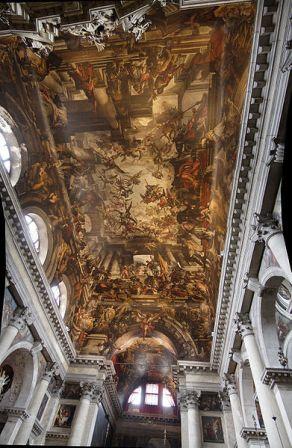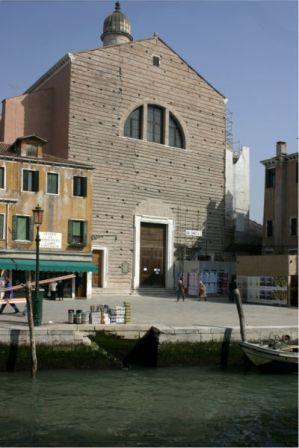One thing I noticed a while ago which gave me a hint that I was becoming even more broken in — like a shoe or a new pair of jeans — to Venice is that I began to look at the death notices taped up around the city. I mean, as if it were possible that I might have known the person.
And by now, I have gone to numerous funerals for one degree of friend or acquaintance or another. Sometimes they’re Lino’s friends, but I get to share.
Today I got a phone call that don Ferruccio Gavagnin has (finally) entered the more abundant life. He was the parish priest of San Pantalon and a true Venetian who grew up in Lino’s neighborhood (San Barnaba) and even on Lino’s street (Calle Lunga). Lino knew him, but was at least a decade behind him, so they didn’t have much connection.
The funeral is going to be Monday, which isn’t good because I’m going to be busy Monday — but I imagine there will be quite a scene. He was 80 years old but he seemed at least 30 years older than that — I think time just got tired and lost track of him. But in spite of pain and infirmity toward the end he carried on through sheer, unadulterated, industrial-strength grit. He was like a goddam racehorse who keeps going on a broken leg.

In the last few years of his life he was very ill with assorted maladies, which I never completely understood. I believe it started with a small stroke one night. After his ancient mother died (she had lived with him in the rectory, where he took care of her; “Priests are good at taking care of other people, but they never seem to take care of their own family”), he lived alone for several years until the night he suffered some brainal lapse which caused him to lose his balance and fall down the stairs.
The stairs are stone, narrow, and extremely steep. He lay there all night with nobody to even imagine he needed help, much less provide it. The next morning the sacristan came to work (Odd, the door is still closed?) and found him lying there, all busted up. Things got progressively worse, as you might imagine. I’ll just leave it at that. But he really hung on, even when he was finally in a wheelchair (they installed a transporter on the staircase). Retire? Surely you jest.
There were times when I’d go by the church in the afternoon, when it’s open to the public. People come in to look at the painting (not a fresco) on the ceiling. It’s the church’s main attraction, a ponderous Baroque effort depicting The Martyrdom and Apotheosis of San Pantalon by Gian Antonio Fumiani (painted between 1680-1704) and it is cautiously described as being perhaps/probably the largest oil painting in the world. It’s not at all beautiful but it’s as big as your average Mongolian steppe.
Don Ferruccio would be sitting there at a desk in the back, to the left. He might be waiting for the kids to show up for catechism, but he was mainly keeping an eye on the place as tourists wandered in and out. He would have made an excellent Electrical/Operations Officer on a nuclear submarine, or maybe a meat inspector for the Department of Agriculture. Whatever you can think of that requires a relentless level of vigilance.
In the winter he would still be at his post, wrapped up in a heavy coat. We would sit there in the enveloping chill, bantering — he was very good at banter, especially the pretend-insulting kind — but our banter was limited by two things. One, he had a way of masticating his words that made it hard to understand him, and the other was the way he kept interrupting the conversation with comments sotto voce on the visitors and what they were doing, and the fact that virtually all of them entered and left without leaving so much as one (1) coin in the offering box.
I often wondered how he must have appeared to the unwary tourists who stepped in out of mere curiosity or to have a chance to sit down for five minutes. There he was, a shrunken, gristly little figure bundled in black, giving sudden sharp thwacks on the desk with his cane to draw their attention to whatever error they were about to commit. Don’t go there! Don’t touch that! I considered myself his friend but he would make even me jump.
Inexplicably, I have no photograph of him to add here. But I will gladly contribute what I wrote about him in 1994 (“Venice: More than a Dream,” National Geographic, February, 1995):
“Meanwhile, somewhere in or around the church of San Pantalon, don Ferruccio Gavagnin is also hard at work. He is always working: He’s the priest of what is technically the smallest parish in Venice, but his congregation won’t stay small. ‘The other priests are a little bit jealous,’ he says. ‘But I can’t refuse people. If they need help, they know they can find me.’

Don Ferruccio has been at San Pantalon for the past 26 of his 41 years as a priest [today that would be 41 of his 56]. He’s balding, compact, and his keen, kind eyes framed by steel-rimmed glasses miss nothing. He has a tendency to bustle, and a let’s-get-on-with-it way of talking. He’s up at 5:00 to pray, do paperwork, and look after his 93-year-old mother, who lives with him in the small house attached to the church. At 7:00 he opens the church, and eventually, being a shepherd, he heads out to check on his flock.
In and out of shops and cafes, a quick cup of coffee, a quick word, a smile, a wave — into the butcher shop, into the optician’s shop, into the firemen’s headquarters (he’s their parish priest). We stride down the street past the church of San Silvestro — “The ugliest church in Venice” — we pause in the church of the Frari, where he speaks with one of the friars about the bishop’s impending visit. I notice that the friar smiles at him with particular coolness — the interparish rivalry continues.
There’s always too much to do. Catechism classes, visiting the sick in four different hospitals, planning a funeral or a wedding. ‘Yesterday was a hard day, and at the end of the day I received two young people who asked me to marry them. They met at a hospital — they both had an eye disease. I told the boy, ‘You probably didn’t see her properly.’
You can’t lure Don Ferruccio into a long conversation; he has no time, and less inclination. Favorite Bible story? He twinkles at me; not a chance. Besides, ‘I don’t believe in words,’ he tells me briskly. ‘I believe in deeds. Words are not important.’
There is a long, slender crack in the austere, dark-brick facade of the church of San Pantalon. Don Ferruccio says it’s always been there; a surveyor recently reported that it might, or might not, get worse over time. As long as don Ferruccio is there, I don’t think it would dare get worse.”

5 Comments
Thank you for this story: don Ferruccio was zio Ferruccio for me, I am his niece.
I’m touched that you wrote; I didn’t know anything about his family. If you have anything you’d like to say about him or your memories of him, please feel free to write them to me. Whether you do or not, though, you have my sincere condolences.
thank you for this portrait.
I just knew the notice, five minutes ago, and I looked immediatly to find some news and photo about him: I found your words. Really touching.
I was born and lived behind that beautiful church lot of years and I could appreciate Don Ferruccio in his best years, when he was young and strong: it was so rich of joy and so natural his way to be close to the faith, and I’ve never found anything similar, anything like that simplicity, that true sense. I played the bells for him; I accompanied tourists for him; I help to keep children for lessons for him; I sung for Christmas for him: all toghetr with lot of other boys and girls which I hope to see on Monday.
Thnak you Don. And tahnk you again for your words: I’ve could see him again.
Dear Anna, It makes me feel happy to know that he is remembered the way you do, and I’m sure many others share your affection and esteem for him. I wish I could have known him earlier, but even so — an unforgettable and, I think, completely honest person. He must have driven the Big People in the diocese crazy.
Thanks Erla, for sharing don Ferruccio. I’m richer from your care for his life.